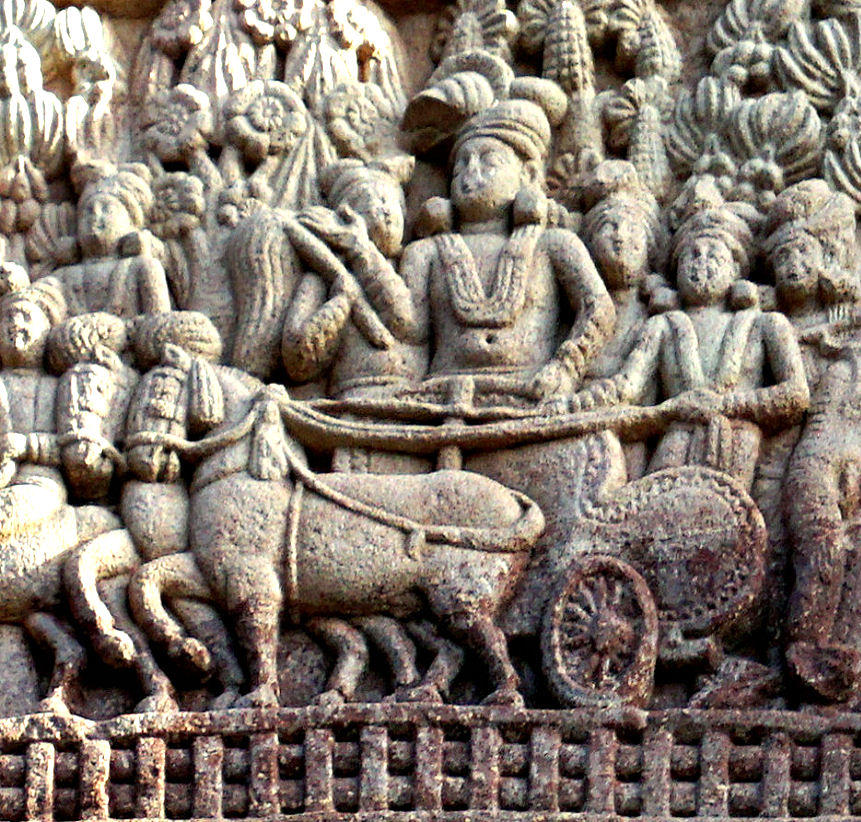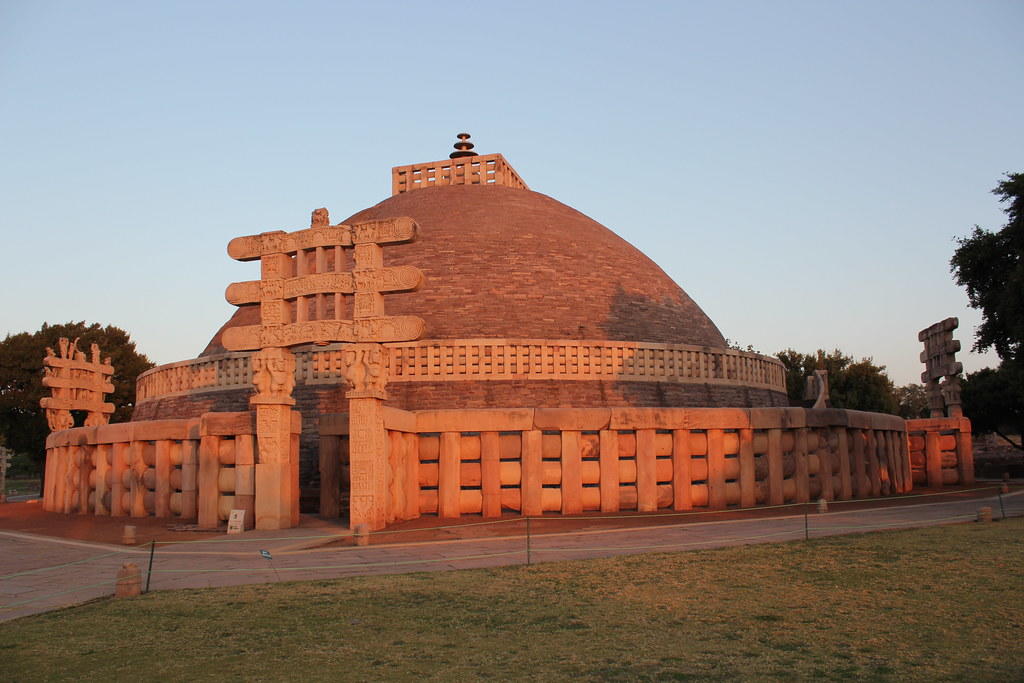Since Buddhism is less popular today than it was in previous centuries, it’s easy to forget just how prolific this ancient religion once was, and that it was observed by powerful rulers in their time.
The monuments in Sanchi remind us that Buddhism wasn’t always the relatively small religion in the background as it often appears to be today.
This amazing Buddhist complex serves as an educator and reminder of the history and beliefs of Buddhist religion and culture.

Who Built Sanchi Stupa?
Monuments always have an origin story, and rarely are they straightforward or dull. History is full of surprises, like the events that led up to the initial construction of the Sanchi Stupa monuments.
War and Peace
In the 3rd century BCE, Emperor Ashoka the Great began construction on the monuments at Sanchi.
He was the third Mauryan Emperor of Magadha, reigning from circa 268 - 232 BCE. Around 260 BCE, in his eighth year reigning, Ashoka was victorious in a brutal war against Kalinga, to annex the land. The victory ensured that the Mauryan Empire stretched from modern-day Afghanistan to Bengal, and down the subcontinent except for the Southernmost tip.

This was the last great battle fought in the name of land annexation in ancient India, at the cost of (estimated) 150,000 to 250,000 lives.
It seems that in the aftermath of the battle, Ashoka felt guilty and remorseful for the bloodshed and devastation he caused, and vowed to never fight a battle for conquest again. He was a changed man.
Embracing Buddhism
According to the Edicts of Ashoka, after the Emperor swore off senseless violence, he began to practice the pillars of Buddhism. Before he was Emperor, it’s rumoured in history that he killed many of his brothers (99) to ascend to the throne, since he was not the rightful heir. However, historians believe the acts and/or number of killings to be exaggerated to show a greater difference between pre-and post-Buddhism Ashoka.
Some historical records proclaim that Ashoka was given the nicknames “Kamashoka” (in pursuit of pleasure, kama) and “Chandashoka” (Ashoka the fierce, due to evil deeds) before he transitioned into Buddhism.
Either way, after the war, he really did change and devoted himself to the ideals of ahimsa (non-violence) and dharma-Vijaya (victory through dharma). He began to proliferate dhamma and other righteous acts. Though some Edicts and other historical documents show that Ashoka’s transformation was gradual over at least 5 years, not an overnight change the way legends make it seem.
In early life, Ashoka was raised under Brahmanism, though it appears that Ashoka may have been Buddhist before the war with Kalinga. However, if he was, then surely he was not practising it the way you’d expect. Some theorize he was simply interpreting the war as his sort of “Middle Way.”
Over time, he began to practice Buddhism in the traditional sense, and Buddhists became happy to spread the word of his conversion. Eventually, he was given the nickname Dhammashoka (Ashoka the righteous).
The Edicts of Ashoka
What are these Edicts? They are a series of more than thirty inscriptions that appear all over India, in the areas that were once the Mauryan Empire.
They appear in a few different forms, like large or small (major or minor), and either on a rock or pillar. They’re written in different languages, depending on location, so the average person in the area would be able to read them.
The purpose? When Ashoka converted to active Buddhism, he decided it was his purpose to spread the word. These Edicts were like informational posters meant to inform the readers about the benefits of Buddhism and how to become one.
The Edicts explain concepts like morally righteous behaviour, benevolence, kindness to prisoners, respect for animal life, following the word of Buddha, religious tolerance, medicinal treatment and planting fruit and medicinal plants for everyone to use, planting banyan trees for shade, digging wells for clean water, and the history of Buddha.
They were a way for Ashoka to proselytize about Buddhism while telling people about the great things he had done in the name of practising morality. He was leading by example and also telling the people that he was a good ruler.

What Relics Are Housed at Sanchi?
Emperor Ashoka began building many stupas in addition to his Edicts across the empire. He supported Buddhist missionaries and made donations to the sangha (the Buddhist monastic community). Ashoka supposedly helped form the Third Buddhist Council and sent them on missions to spread the word to the people within and outside of the empire, including places like Greece, Sri Lanka, and Thailand.
Building the Stupas
Ashoka may have been the first person to implement building in stone in India, as it would have been usual for the time for buildings to be made of wood, bamboo, or thatch. Turning to stone, which lasts centuries, was a game-changer in Indian architecture. As a result, Sanchi is the oldest Buddhist sanctuary in existence (that has survived to the modern day).
Legends state that Ashoka ordered 84,000 stupas and viharas be built all over India, which were all completed on the same day when Elder Monk Yashas waved his hand, causing a solar eclipse.
Of course, this is legend, not truth. There was in fact an eclipse on 4 May 249 BCE, but that’s the only real fact in the story.
Ashoka may have arranged for a prolific number of stupas to be built in the empire, but surely not 84,000. The goal was to follow the Buddha’s instructions and build places for people to explore Buddhism and structures for devotees to spend time at.
This was especially important for people who lived too far away from the landmarks the Buddha visited in life and the original eight stupas that housed his remains. The thinking was, according to the Buddha, “the hearts of many shall be made calm and glad” with more places to worship.
Does Sanchi Stupa Hold The Buddha’s Remains?
Ashoka wanted to spread the Buddha’s remains from their eight existing stupas to as many different places in the empire as possible, with the thinking that the remains would help spread Buddhism by virtue of existing in a new place. However, the “spreading of remains” was metaphorical, as the stupas built by Ashoka likely do not contain the physical remains of the Buddha.
The Sanchi Stupas do, however, contain the relics (remains, specifically bone fragments, called asthi avashesh) of Sariputra and Maudgalyayana (aka Sariputta and Moggallana) who were the chief disciples of Buddha. Even though legend states they had been buried in Jetavana and Veḷuvana monasteries (respectively) a few months before the Buddha himself died (c. 483-400 BCE), it’s presumed that Ashoka had at least part of their relics relocated to Sanchi.
This was discovered in 1851 when British archaeologists Major Cunningham and Lieutenant Maisey excavated Stupa number 3 at Sanchi, they discovered two sandstone boxes with a steatite casket in each. The caskets each had a Brāhmī character on them that was discerned to indicate the names of the disciples.
Can it be completely verified that these bone fragments belonged to the disciples? There is no way to tell for certain since it’s not as if Sariputra and Maudgalyayana are in a DNA database. However, to date, no evidence of their relics at Jetavana and Veḷuvana has been found. Perhaps Ashoka really did have their relics removed and placed at Sanchi!
Did Ashoka Build All the Stupas at Sanchi?
No, the installation of monuments at Sanchi continued long after Ashoka’s death.
The first of the monuments, The Great Stupa, is one of the oldest, if not the oldest, surviving structures in India. It was commissioned by Ashoka in the 3rd century BCE and supposedly was built around some of the Buddha’s remains. It was expanded upon about 50 years after Ashoka’s death.
In Ashoka’s time, a Pillar of Ashoka was also erected at the site. It would have stood 42 feet in height when intact, but the majority of the pillar is now located in the Sanchi Archaeological Museum nearby. The final surviving known monument from Ashoka’s time is Temple 40, which now stands in ruins.
The other monuments (there are 50 in total) were built after Ashoka’s time.

The Restoration of Sanchi
Sanchi has gone through a few restorations over the centuries and revealed some amazing facts about Sanchi Stupa.
Ancient Constructions and Restorations
As you know, even after Ashoka died, monuments were still being built in Sanchi. In the 2nd century BCE, Sanchi likely suffered some vandalization, resulting in damage to The Great Stupa.
To fix it, the people of the then time period covered the old stupa with large stone slabs and a new addition of a stone dharma symbol on top, nearly doubling the stupa in size from the original dimensions.
More add-ons were made through time, like a balustrade and carvings. More stupas, pillars, and decorated gateways (architraves) were created over the centuries. The low wall surrounding the sanctuary (vedika) and the incredibly detailed gateways (toranas) which face each cardinal direction was built sometime later on.
Monuments to memorialize Ashoka’s actions as well as Buddha’s life and Buddhist ideals were created through time.
The latest known additions to the sanctuary were built in the 12th century CE.
The Rediscovery of Sanchi
Sometime after the 12th century CE, the entire sanctuary was abandoned. By this time, Buddhism was declining, Hinduism and Jainism were on the rise, and later on Islam entered the scene.
The sanctuary had too few followers to continue functioning, and so it fell into disrepair and the last of the people there left. For 600 years, the sanctuary lay abandoned, and the jungle began to grow over the monuments.
But, in 1818, General Henry Taylor stumbled upon the site during the Third Maratha War. He was the first Westerner to document the place, and so it became something of interest to the West: Sanchi was back on the map.
The good news to come from this was that the site was surveyed by Alexander Cunningham (archaeologist, founder of the Archaeological Survey of India government agency) and Frederick Charles Maisey (archaeological surveyor) in 1851, which led to its excavation and preservation by Sir John Marshall (archaeologist) between 1912 and 1919. It was also declared a UNESCO World Heritage Site in 1989.
The bad news was that the site suffered some plundering from treasure hunters until 1881. Additionally, when Maisey and Cunningham excavated the relics of Sariputra and Maudgalyayana, they took them to England in 1866 and gave them to the Victoria and Albert Museum (called the South Kensington Museum at the time).
"No society can prosper if it aims at making things easier. Instead it should aim at making people stronger." - Ashoka the Great
Years later, a Buddhist revivalist movement in South Asia prompted India to request the return of the relics, which the museum eventually reluctantly did after much pressure from the British government, who wanted to preserve diplomacy. The Maha Bodhi Society successfully arranged the return of the relics in 1947. The relics were exhibited all around Sri Lanka and other parts of Asia before being re-enshrined in several locations in 1952. The relics were portioned and now reside in Burma, Sri Lanka, and India, at Sanchi.
The Maha Bodhi Society had a specific monument at Sanchi, the Chethiyagiri Vihara, built to house the returned relics.
Now, Sanchi is carefully looked after, the Sanchi Archaeological Museum seeks to preserve the site and educate the public about its history, and thousands of Buddhists, sightseers, and history enthusiasts visit the sanctuary every year.
Ashoka as a historical figure had almost been forgotten, but thanks to the discovery of Sanchi and the deciphering of the Brahmi script (made possible by discoveries at Sanchi), we now remember his life and achievements.
In fact, the modern-day emblem of India is an adaptation of the Lion Capital (top of a pillar) of Ashoka, and the wheel in the center of the Indian flag today is known as Ashoka’s Wheel (the Buddhist chakra also found on the Lion Capital).
Visiting Sanchi and the Stupa

Here’s what you need to know to have the best visit to Sanchi Stupa.
Where is Sanchi Stupa Located?
Sanchi Stupa is located 46 km (29 miles) northeast of Bhopal in the Raisen District of Madhya Pradesh. It is on a hilltop in Sanchi Town.
When Is the Best Time Of Year to Visit Sanchi Stupa?
The best time of year to visit Sanchi is between July and March. In November, you can attend the Chethiyagiri Festival and witness the annual display of Sariputra and Maudgalyayana relics to the public.
The Stupa is open year-round and you can visit it from sunrise to sunset each day.
How To Get To Sanchi Stupa
You can reach Sanchi easily by road (car, taxi, or bus) because it is well-connected to many nearby major cities.
By rail, the most convenient rails are Visisha and Bhopal. Sanchi lies on the Jhansi-Itarsi section of the Central Railways.
By air, you can fly to Bhopal Airport and take a taxi to Sanchi.
What is the Entry Fee for Sanchi Stupa?
Sanchi Stupa is very affordable. For Citizens of India, SAARC, and BIMSTEC countries, the fee is only Rs. 40 per person. For foreigners, the cost is Rs. 600 per person. However, children under the age of 15 can enter for free.
There is no specific dress code for Sanchi Sanctuary, but it’s recommended to cover the elbows and knees in respect of the monument and other visitors. Also, keep in mind the tropical climate and dress wisely!
References
- Centre, UNESCO World Heritage. “Buddhist Monuments at Sanchi.” UNESCO World Heritage Centre, whc.unesco.org/en/list/524/. Accessed 27 Nov. 2023.
- “The Great Stupa at Sanchi.” World Heritage Journeys Buddha, visitworldheritage.com/en/buddha/the-great-stupa-at-sanchi/afc71819-5d92-4767-9fa5-1d8069df0521. Accessed 27 Nov. 2023.
- “Sacred Sanchi.” MPTourism, www.mptourism.com/destination-sanchi.php. Accessed 27 Nov. 2023.
- “Sanchi Stupa, Buddhist Monuments.” Sanchi Stupa, Buddhist Monuments, www.sanchi.org/. Accessed 27 Nov. 2023.
- Dr. Karen Shelby, "The Great Stupa at Sanchi," in Smarthistory, December 14, 2018, accessed November 23, 2023, https://smarthistory.org/the-stupa-sanchi/.















